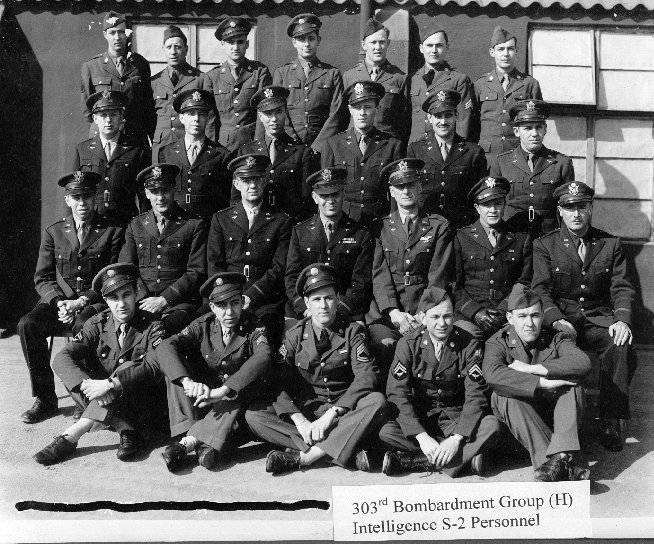 |
S-2 Intelligence Personnel |
Personnel
Mission Reports

303rd S-2 Intelligence Personnel
(Top Row) M/Sgt Karl W. Lamb, Sgt George W. Christenson,
Sgt Joseph W. Schultz, Sgt Howard A. Seidler, Sgt James H. Sackel,
S/Sgt Claud B. Whitson, Sgt Thomas V. Basden, Jr.
(3rd Row)
Capt Joseph G. Robinson,
1Lt George D. Conrad,
Capt Walter G. Donnelly,
1Lt Robert B. Whitehead,
2Lt Roger A. Prior,
Capt John C. Higgenbotham
(2nd Row)
Capt Charles D. McQuaid,
Maj Claes E. Johnson,
LtCol Jesse M. Barrett,
Maj Charles A. Green,
Capt Thomas A. Gabbert,
Capt Allan S. Lund,
Capt Bert S. VonSchmidt
(Front Row)
Sgt Rowland E. Eng,
S/Sgt Gerald W. Reddick,
Sgt Raymond E. Grinroth,
Sgt Roy J. Buis,
unknown
[photo from the 303rdBGA Archives]
By Carlton M. Smith, Group Photo Interpreter
Back in the war years S-2 designated the Intelligence Staff of a military unit. In the Headquarters building at Molesworth that staff occupied a room between S-1 (Personnel) in the front of the building and S-3 (Operations) in the rear. Across the street from the flagpole and just beyond an open field were the briefing rooms and the map room which were a part of the S-2 complex.
A typical S-2 staff of an 8th Air Force bomb group consisted of the Group Intelligence Officer, the Group Photo Interpreter, a senior NCOIC, an NCO for the map room and the escape and evasion material as well as one or two additional NCOs. Supplementing this small crew were the Intelligence Officers and staff from the four combat squadrons who had desks in the Group office. Each squadron usually had two officers and four NCOs so there were adequate numbers to operate on a 24-hour basis. At first glance it might appear the organizational structure was contrary to effective management with the personnel answering to both the S-2 Officer and their squadron commander, but this was no hindrance to effective operation in the 303rd Bomb Group. Dedication to a common mission outweighed parochial ties. Duties were assigned and performed by mission functions rather than by squadron designation.
To walk through a typical mission, it would start with the receipt of the field order from Operations. The briefing officers would prepare their notes, maps, photos and other material while the NCOs would post the routes on the maps, prepare the mission kits for the bombardiers and navigators, make up the escape and evasion kits and be ready to assist in the briefings. Usually there was a separate briefing for pilots, bombardiers, navigators and gunners. All would be advised of the importance of the target, flak and enemy fighter threats and recommended escape and evasion procedures. In addition, the S-2 briefing for bombardiers would include detailed target identification information and bomb run landmarks beginning at the initial point (IP).
When the aircraft returned from the mission the S-2 personnel became interrogators. It was then their job to obtain as much information as possible from physically tired crews who were often more anxious to hit the sack than talk about that from which they had just returned. It required tact and understanding yet a prodding for details which made up the required reports that were due in higher headquarters a few hours later. There was always a mission summary report which had to be compiled and very important for future operations was the flak report. The reports of crew comments and fighter claims were no less important.
As soon as the strike photos were received from the photo laboratory the Photo Interpreter plotted the bomb patterns of each squadron, determining the centers of these patterns and comparing them to the assigned mean point of impact (MPI). From this, a degree of bombing accuracy (range and deflection) could be recorded. The last phase of the PI Report was a damage assessment. The report was sent ASAP to the Group Commander, but it was also of much interest to the bombardiers and many made post-mission stops at the PI desk to review the photos. As the PI, I became close to many of the bombardiers because of this common interest and it was a natural for me to do the bombardier briefings and target identification classes. To upgrade my capabilities in this area I flew missions in various positions of the aircraft and to various types of targets. I don't know what the S-2 Staff did in other Groups, but in the 303rd at least two of us "ground pounders" came home with Air Medals. I mention this not as an ego trip, but to illustrate the extent of dedication in a Group called the Hells Angels.
Who were some of the names behind these desk jobs? As far as this writer can recall, they were:
- Major Jesse Barrett
- Major Claes Johnson
- Major Charles McQuaid
- Capt Joseph Robinson
- Lt Peter Curry
- Lt Tony Ficovich
- Lt David Fraser
- Lt Robert Shaw
- Lt Carlton Smith
- MSgt Karl Lamb
- TSgt Joseph Weinheimer
- SSgt George Christenson
- SSgt Jerry Reddick
- SSgt Joseph Schultz
- SSgt Robert Thoma
- SSgt Claude Whitson
- Sgt Milton Klabe
- Sgt Howard Seidler
- Cpl Roy Buis
- Cpl Rowland Eng